Call us at 725-239-9966!
M-F: 8 AM-7 PM PST
Call us at 725-239-9966!
M-F: 8 AM-7 PM PST

A beautiful outdoor gazebo can transform your backyard or garden into a charming outdoor living space for relaxation and entertainment. However, with so many shapes, sizes, and styles of gazebos available today, choosing the right one for your needs can be overwhelming.
This comprehensive gazebo buying guide will walk you through all the key factors to consider when investing in a new gazebo so you can select your dream backyard shelter with confidence.
Carefully measure your outdoor space to determine the right gazebo size and layout. Leave room for landscaping and furnishings.
Pick a durable roof material like vinyl, aluminum, or weather-resistant shingles for all-weather protection.
Anchor the gazebo securely into the ground with footings or anchor bolts to prevent shifting.
Add convenient accessories like lighting, fans, outlets, and storage benches to customize your gazebo.
Perform regular maintenance like power washing, caulking, and tightening hardware to maximize longevity.

One of the most important decisions when choosing a gazebo is selecting the proper gazebo size. You'll want to think about both your available space as well as your intended uses for the gazebo.
Measure Your Area
First, measure the area where you plan to situate the gazebo, including length, width, and height allowances. Make sure to follow the spacing guidelines for gazebos so you have enough space available around the structure for easy access and landscaping if desired.
Consider Your Needs
Next, think about how you plan to utilize the gazebo. Will it be used mainly for cozy 2-person meals? Leisurely Sunday brunches? Family gatherings or parties? If you plan to furnish the interior with seating, dining sets, etc., measure these fixtures and allow ample moving space too.
As a general rule of thumb, an 8x8 foot or 10x10 foot gazebo can comfortably fit a bistro set. A 12 ft gazebo or larger octagon gazebo provides enough room for a table and chairs. For bigger groups, a 14x14 foot or 16x16 foot square gazebo is ideal.
Leave Room to Spare
It's better to err on the side of getting a slightly larger gazebo rather than having one too cramped for your purposes. But beware of going overboard either - a huge gazebo crammed into a tiny yard will look and feel ridiculous. So choose an optimal gazebo size that fits your needs and layout.
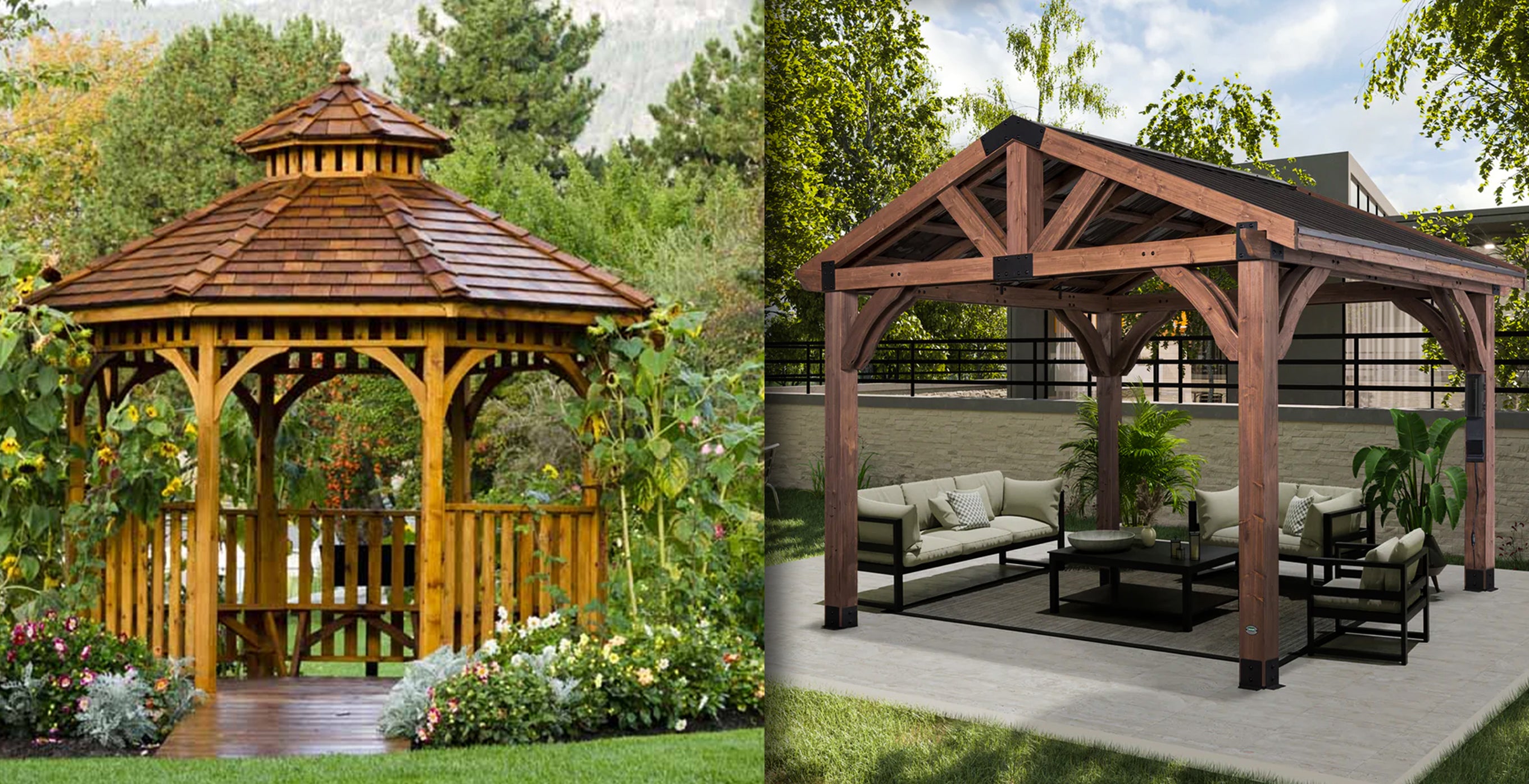
In addition to determining the right size, gazebos come in a variety of shapes, architectural styles, and decorative detailing that allow you to match your tastes and landscape aesthetic.
Common Gazebo Shapes
Square/Rectangle - Classic and functional, square or rectangular gazebos are the most common shape. They maximize interior seating capacity due to their efficient footprint.
Octagonal - Octagon gazebos have eight sides for visual interest and often suit gardens well. The many corners and roofline provide character while still offering spaciousness.
Oval - Oval or elliptical gazebos complement curvilinear gardens nicely with their rounded footprint. They feel more ornate than squares or rectangles.
Gazebo Styles
Gazebos range from simple to ornate. Stylistic options include:
Traditional - Features decorative woodwork like turned posts, cupolas, and gingerbread trim.
Contemporary - Clean lines, little ornamentation. Often metal, glass, stucco, or wood tones.
Cottage - Evokes casual country charm with painted colors, window boxes, and charming accents.
Classic Pavilion - Greek/Roman-inspired columns, pediments, domed or vaulted ceilings.
Custom Touches
Personalize your gazebo with upgrades like storage benches, ceiling fans, lighting, transparency panels, screens, glass walls, and more.
Gazebos are constructed from various materials, each with its own aesthetic and functional pros and cons.
Wood
The quintessential choice, a natural wooden gazebo evokes a timeless elegance. Cedar and redwood are naturally resistant to rot and insects. Though pricier, wood offers character and style while being a good insulator. Protect and maintain with staining.
Vinyl
A low-maintenance alternative to wood, vinyl gazebo kits feature PVC exterior walls. Vinyl resists moisture, mildew, and pests. It holds paint well for color options and is easy to clean. More affordable yet still elegant.
Aluminum
Lightweight yet very durable, aluminum gazebos resist corrosion and decay. They offer simpler assembly, hold up well in all weather, and require little yearly maintenance. Choose powder-coated or anodized aluminum.
Steel
An extremely strong and heavy-duty option capable of withstanding severe weather. Prone to rusting so opt for stainless or galvanized steel. Often used for screened gazebo frames.
Other
Less common alternatives include brick, stucco, concrete, and wrought iron gazebos. Weigh cost, appearance, and maintenance when evaluating.
| Material | Pros | Cons |
|---|---|---|
| Wood | Natural beauty, a good insulator | Expensive, high-maintenance |
| Vinyl | Low maintenance, affordable | Less durable than wood |
| Aluminum | Durable, low-maintenance | Can be prone to denting |
| Steel | Very durable | Rusting issues |
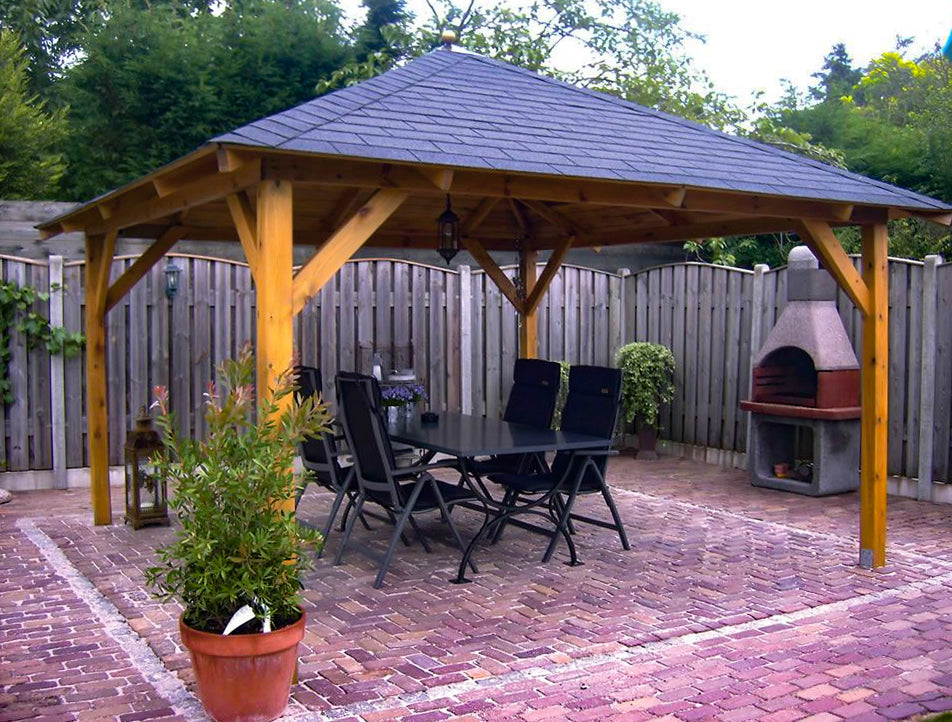
To maximize your gazebo's lifespan while minimizing repairs and upkeep, ensure it can handle all types of weather conditions and wear and tear.
Wind and Rain
Reinforced metal roofs and resistant synthetic canopy materials (like polycarbonate or PVC) stand up to heavy rains, snow, hail, and high winds. However, a sturdy gazebo roof alone is not enough - you still need some effective methods to keep the gazebo in place during high winds.
All-Season Use
Look for an all-weather gazebo if you plan to enjoy it year-round. Rot and corrosion-resistant materials hold up better. Check the snow load rating if applicable.
Insulation
For four-season gazebos, insulation panels or insulation-boosting double roofs help moderate interior temperatures during extreme cold and heat.
Shingled Roof
For wet climates or to match a shingled home roof, opt for authentic composition, asphalt, metal, or synthetic shingles. If the gazebo doesn't come with a shingled roof, you can shingle the gazebo yourself.
Raised Floors
Elevated floors prevent interior water penetration while allowing ventilation and drainage underneath.
Gazebos represent a significant investment, though prices vary based on size, materials, complexity, and accessories.
Gazebo Cost
The gazebo itself starts around $1,000 for simple vinyl pop-up models. Prefab wooden gazebos range from $2,000 to $7,000. Custom build options exceed $10,000. When buying, this is the main cost you have to give the most attention and ensure you're getting a good deal.
Delivery/Installation
Prefabs include delivery and setup assistance. For custom builds, delivery and construction range from $1,500 to $5,000 depending on complexity. This is where you can cut the most.
Foundation
Basic platforms cost $500-$2,000. Concrete slab installation generally spans $3,000 to $5,000. Complex footings with excavation easily reach $10,000+.
Electric/Lighting
Running underground electrical cables and installing lighting/fans/outlets can add $500 to $2,000+ to budgets. But that's an accessory, so you can leave it.
Permits
Building permits for permanent gazebo construction average $200-$500 but vary by municipality.
TOTAL
In total, plan around $5,000 - $15,000+ for a significant backyard gazebo installation.
| Component | Cost Range |
|---|---|
| Gazebo structure | $1,000 - $10,000+ |
| Delivery & installation | $1,500 - $5,000 |
| Foundation | $500 - $10,000+ |
| Electric & Lighting | $500 - $2,000+ |
| Permits | $200 - $500 |
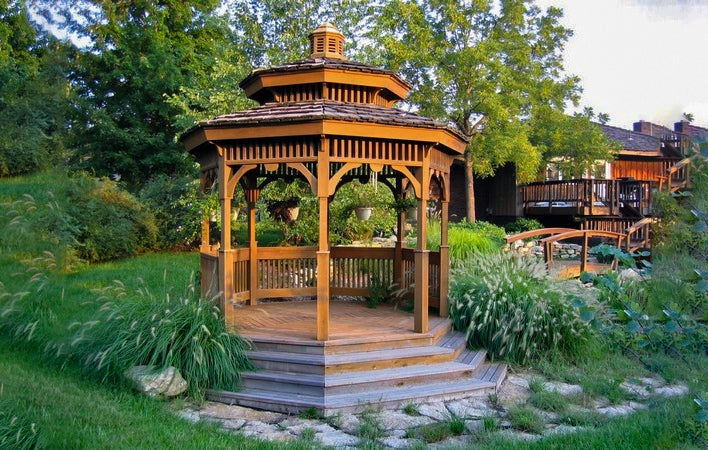 Plan Your Gazebo Placement
Plan Your Gazebo PlacementAfter buying the gazebo, it's time to decide where to situate your new gazebo on your property requires careful thought.
Sun and Shade
Do you want to bask in the midday sun or relax in the shade? Track sunlight patterns in your yard throughout the day. Sheltered spots under or beside trees work for shade lovers.
Views
Frame alluring views of gardens, landscapes, or water features. Avoid unsightly views like air conditioning units or neighboring fences.
Accessibility
Pick an easily accessible location close to the home with a clear flat path. Ensure electrical, water, or gas lines for the gazebo don't obstruct walking areas.
Privacy
Certain areas feel more secluded from neighbors while still being visible from your home. Take privacy into account depending on gazebo activities.
Terrain
Evaluate the ground surface. Avoid overly sloped or uneven areas that require complicated foundation work.
Anchor Point
Consider where and how to anchor the gazebo based on the surface below.
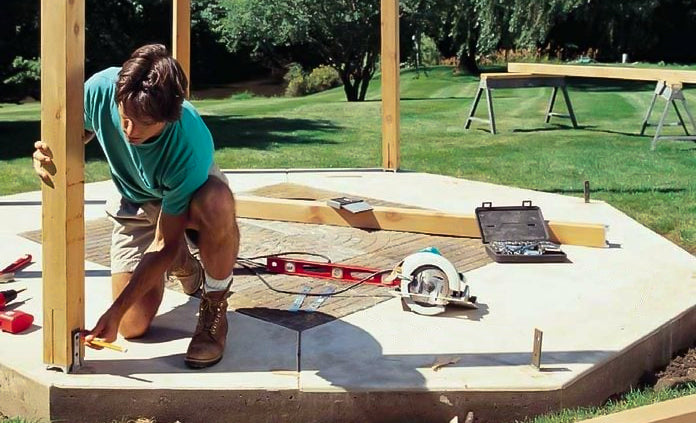
Installing a proper gazebo foundation is crucial for structural stability, safety, and weather resistance.
Platform
Prefabricated platforms provide a flat surface for attaching a gazebo on uneven ground. Elevated platforms also reduce moisture and pests while hiding anchoring mechanisms discretely.
Concrete Footings
For permanent gazebo installations, concrete footings poured below the ground offer the strongest anchoring. They prevent shifting and resist frost heaving in cold climates. The frost line depth determines the footing size for a gazebo.
Anchor Bolts
Steel anchor bolts embedded within concrete footings secure the gazebo tightly. Choose corrosion-resistant galvanized or stainless steel anchors with nuts/washers.
Ground Screws
Auger-style helical ground screws drill into the earth to anchor a gazebo without concrete. Best for sandy soil rather than heavy clay. They are removable for relocation or adjustable for leveling.
Tie Downs
For added wind resistance, secure the gazebo roof and framework with metal tie-downs, stakes, or straps fixed to the ground.
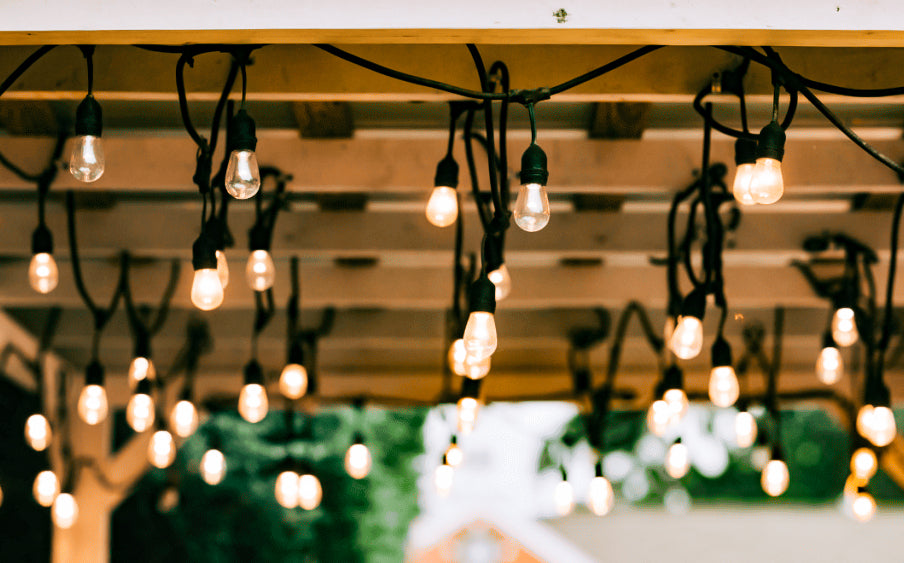
Once you've covered the basics, it’s time for the fun stuff - picking gazebo options and extras that match your priorities for functionality and ambiance.
Lighting
Create a magical nighttime hangout with lighting fixtures like pendant lights, post lamps, or spotlights. So make sure to run electricity to a gazebo when installing it.
Ceiling Fan
Install a ceiling fan for creating circulating air and a breeze effect for enclosed gazebos. Most attach to a standard electrical box mount on the roof.
Power Outlets
Outfit your gazebo with accessible exterior-rated outlets to easily plug in lights, appliances, devices, speakers, or décor.
Storage
Stay organized with built-in storage like shelves, cabinets, or bench seats with hidden compartments or drawers.
Screens
Retractable insect screening on doors, windows, or roof vents lets you enjoy fresh air minus the bugs.
Side Panels
Clear vinyl, acrylic, or screen panels enclose the gazebo perimeter to create a sunroom effect or block wind/debris. Removable for openness.
Window Boxes
Built-in window boxes beneath framed openings lend charming cottage appeal for planting flowers or herbs.
Furnishings
Chairs, loveseats, side tables, and other complementary outdoor furniture furnish the gazebo interior.

To keep your gazebo looking its best for years to come, be diligent about regular upkeep and fixing minor issues before they worsen.
Cleaning
For vinyl, aluminum, steel, or other solid gazebo materials, wash down surfaces with mild soap and water using soft bristle brushes. Avoid harsh chemicals.
Stain/Paint Touch-Ups
Reapply protective wood stains, paint or powder coat finishes whenever they appear faded, cracked, or patchy to prevent moisture damage, as explained in this guide on how to paint a gazebo.
Sealing
Fill any small gaps in roof panels, rafters, sidewalls, etc. with caulk or sealant to prevent pesky leaks.
Hardware/Connections
Inspect nuts, bolts, hinges, and other hardware a few times per year. Tighten or replace loose parts promptly.
Pest Prevention
Clear out cobwebs and hive intruders regularly to prevent birds from building nests. Apply shields/netting if needed.
Leveling
Re-level the gazebo if settling or distortion occurs using shims or adjustable footings. You can also increase the height of the gazebo if you want to.
Ventilation/Moisture Control
Promote airflow and drainage to prevent humidity and condensation issues. Open vents, windows, curtains.
Drainage
Ensure rain or melting snow flows away from the gazebo to prevent water from pooling on the gazebo roof.
Thoroughly measure your intended gazebo footprint and check local codes on size/placement.
Examine gazebo samples in person at stores to assess the quality of materials, craftsmanship, and ambiance.
Consult reviews and check company reputations when choosing gazebo manufacturers.
Factor in long-term costs not just the initial purchase price, like maintenance, utilities, and insurance.
Hire experienced landscape designers if you need drainage grading, foundation excavation, or electrical.
For gathering spots, allow 7-15 square feet per person inside the gazebo.
Get all necessary permits and approvals in place before installation day.
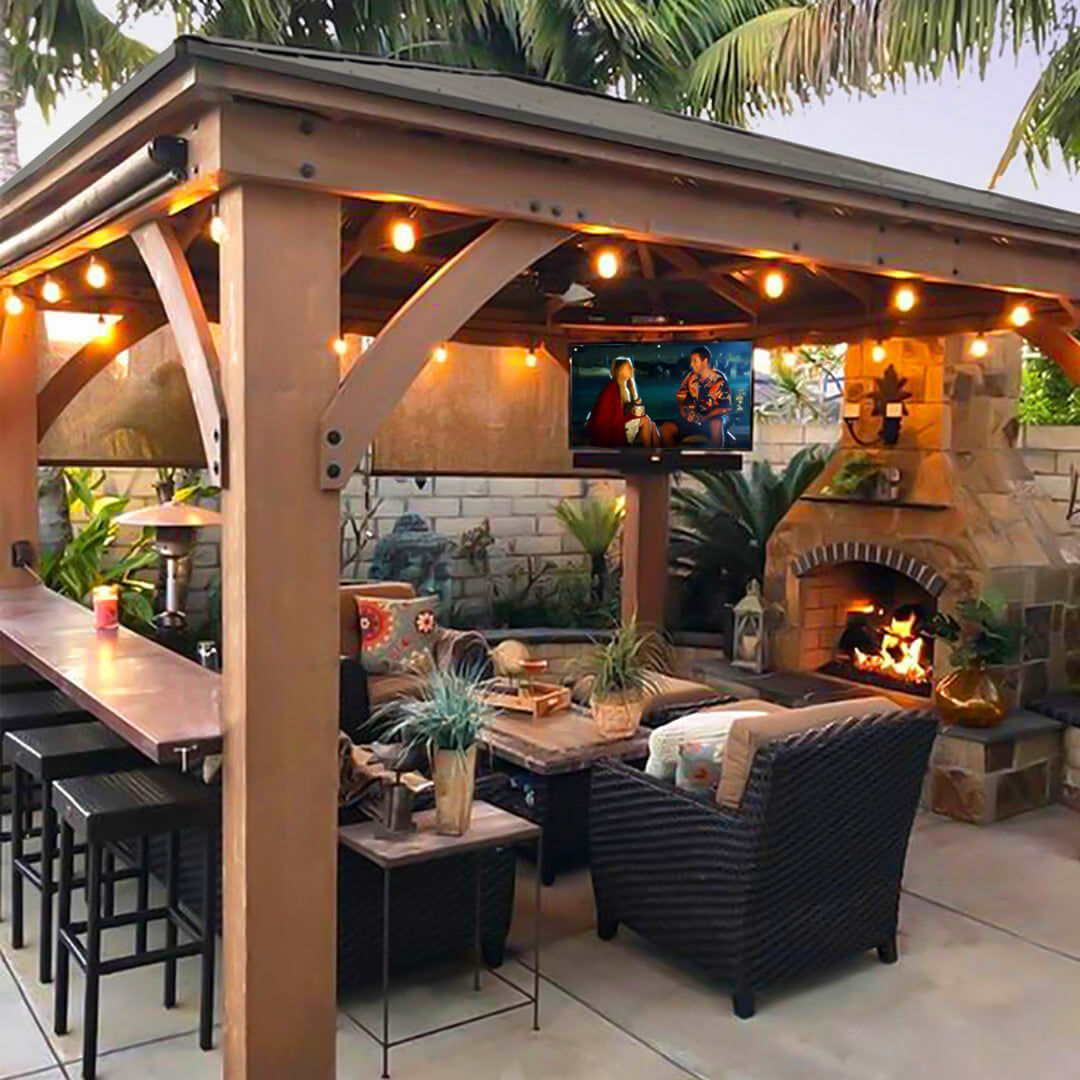
Adding an elegant new gazebo truly completes your perfect backyard oasis for hosting, decorating, conversing, dining, and just plain unwinding. By carefully considering all the options and factors covered in this gazebo buyer’s guide, you’ll be well-equipped to create your ideal outdoor living space.
Before you know it, you’ll be cozily tucked away in your new favorite gazebo - sipping morning tea, reading on a rainy afternoon, or toasting marshmallows late into the starry summer nights. So go ahead... picture yourself relaxing, laughing, and making memories in your gazebo. The backyard of your dreams awaits!
Yes, the type of roof on your gazebo may impact both its appearance and functionality. Some gazebos come with a canopy that may be removable or retractable. Other gazebos may have a more solid roof made of wood or metal. If you plan to use your gazebo in all types of weather, you might want to consider a gazebo with a sturdy, weather-resistant roof.
A: While gazebos are perfect for providing shade in the summer, many gazebos can also be used in the winter. For example, an enclosed wood frame gazebo with a sturdy roof can protect against snow and wind, making it a functional outdoor space all year. However, it is important to check the manufacturer’s recommendations as not all gazebos are designed to withstand harsh winter conditions.
Gazebos enhance outdoor space by offering a focal point and a sheltered area to relax or entertain. Gazebos are often used to define a specific area, like a dining or lounging space. A gazebo provides shade and protection from the elements and can add character to your garden or patio.
Yes, you can definitely add a gazebo to your existing outdoor space. Gazebos offers a quick and easy way to change the look and feel of your outdoor area. However, you may need to consider whether you have enough space and if the style of the gazebo matches the overall look of your outdoor space.
Depending on the type of gazebo, the installation could be more or less challenging. Pop-up gazebos are usually quick to set up and take down. However, larger or more permanent gazebos may require professional installation due to their weight and complexity. To be sure, always check with the retailer or manufacturer about the installation process.
With proper care and maintenance, a quality gazebo can last for several years. The longevity of a gazebo also greatly depends on the quality of the material used to construct it. For example, aluminum gazebo kits or vinyl can often withstand the elements better than wood gazebos, potentially leading to a longer lifespan.

{"one"=>"Select 2 or 3 items to compare", "other"=>"{{ count }} of 3 items selected"}
Comments
Leave a comment